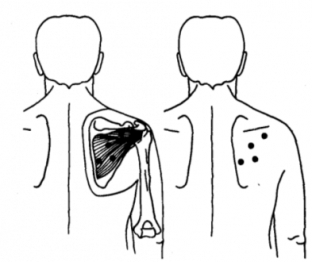If you're experiencing pain in the front of your shoulder and arm, you may not know it's from the infraspinatus muscle in your back. The infraspinatus muscle fills the entire infraspinatus fossa of the scapula, departs from it laterally and is attached to the back of the tubercle of the humerus. The infraspinatus muscle performs two important functions – abduction of the arm to the side (during contraction, the muscle turns the arm outward at the base of the shoulder) and stabilization of the shoulder joint.
The teres minor and deltoid muscles assist in lateral rotation of the arm, and the rotator cuff muscles help stabilize the shoulder joint during arm movements. Main antagonist muscles: subscapularis and pectoralis major muscle, the action of which is directed to the medial rotation of the arm.
Infraspinatus trigger points: where pain occurs
Very often, three painful points appear in this muscle, by connecting which, you can get a triangle. The lower trigger point occurs most frequently in people complaining of shoulder pain.
Pain from these trigger points radiates deep into the front of the shoulder joint and across the upper arm. In advanced cases, the pain can spread along the forearm and to the end of the arm.
Read also: Subscapularis trigger points: how to recognize the problem and manage pain
Thus, the main symptoms of infraspinatus trigger points are:
- pain in the front of the shoulder (main symptom) that is felt deep in the shoulder joint;
- pain when putting the arm behind the back (e.g. to fasten a bra);
- pain when raising the arm above the head;
- pain when trying to get up (for example, from bed), leaning on hands;
- shoulder pain at night;
- pain in the front of the upper arm.
It is worth noting that pain caused by infraspinatus trigger points is often accompanied by the appearance of trigger points in the supraspinatus and deltoid muscles.
Below estet-portal.com will consider:
- reasons for the appearance of muscle knots;
- Self-massage to relieve pain caused by the infraspinatus.
Causes of trigger points (muscle knots) of the infraspinatus muscle
The main cause of trigger points is muscle overexertion. In the case of the infraspinatus, the source of the problem may be the need to pull the arm back or keep the arm extended forward for a long time, for example:
- throwing the ball;
- tennis games;
- long work at a laptop or PC without elbow support;
- unsuccessful fall;
- long driving, during which the hands are placed on top of the steering wheel, etc.
Infraspinatus Trigger Point Massage for Pain Relief
Even if the source of pain is muscle knots, it is best to seek help from a professional who understands anatomy and can accurately identify the muscle (or group of muscles) that needs to be worked on.
If you experience persistent pain in your shoulders or arms, you should see a doctor who can make a diagnosis after assessing your condition and point out the cause of the problem.
In any case, to get rid of the pain caused by trigger points, you must first determine their location. In the case of the infraspinatus muscle, it is necessary to look in the area of the shoulder blades (see the figure below):

Your task – press on the indicated points. If pain is felt on palpation (and pain also appears in the front of the shoulder or radiates to the arm), you have found a point to work from. Also important to know:
- execution technique;
- massage duration.
Infraspinatus self-massage technique
Self-massage can be done with fingers, elbow, tennis ball, massage roller or other devices. However, in this case, taking into account the location of the infraspinatus, it is best to either use a tennis ball (lying on the floor) or ask another person for help.
Remember: massage should not be very painful, so adjust the pressure (on a scale of 1 to 10, pain should be in the range 4 & ndash; 7). Massage the points in small circular motions or move along the muscle fibers.
When the massage is performed correctly, you will feel how the pain goes away. In some cases, the pain may increase slightly, but be accompanied by a feeling of pleasant relaxation.
How long should an infraspinatus massage last
In some cases, only 10-30 seconds of self-massage once a day is enough to relieve pain until the discomfort is completely eliminated. In more serious cases, you can increase the massage time to 1–5 minutes and perform the procedures every day for 2–7 days.
Read also: Ladder muscle massage for pain in the neck, chest, arms and upper back
Self-massage of the infraspinatus muscle – a great way to get rid of pain caused by overexertion of muscle fibers. However, estet-portal.com reminds that this method will provide only a short-term improvement in well-being, and for a permanent effect, it is necessary to neutralize the factors that lead to overstrain of the infraspinatus muscle, the most common of which is incorrect body position when working at a PC or laptop.
You may be interested in the video:






Add a comment